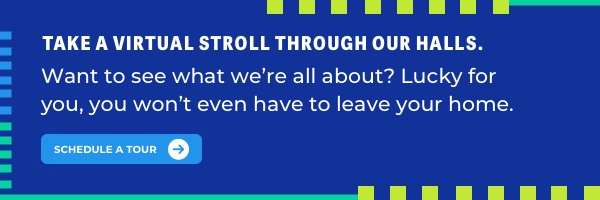The Go-To Guide to Understanding How Charter School Financing Works
Because of the competitive nature of funding, there is controversy and confusion swirling around charter school financing.
Unfortunately, not clearly understanding a school’s funding sources puts parents at a disadvantage. After all, if you want to know how well a school is prepared to promote learning growth, you need to know where its resources are coming from.
We’re here to clear the air about school funding once and for all. In this guide, we bust the myths surrounding charter school financing and explain how it works.
How Does Charter School Financing Work?
Broadly speaking, charter schools are funded by a combination of various tax revenue sources, primarily through state taxes. That means charter schools receive public financing, are tuition-free, and are open to all students—just the same as traditional public schools. Also like district schools, charter schools are awarded finances based on the school’s enrollment figures.
However, the amount and share of funds that the government sets aside for charter schools varies from state to state. Another big difference between charter school and traditional public school funding has to do with facilities. In most cases, charter schools don’t get money from the state to build facilities.
The Truth Behind Common Myths About Charter School Financing
Sadly, there are myths about charter school financing that both overshadow the truth about financing and confuse parents. Here’s the truth behind some of the most common myths about charter school funding:
MYTH: Charters Are Privately Financed and Run
Possibly because they have more flexibility than traditional public schools, charter schools are often thrown into the same category as private schools. However, charter schools are not privately funded or run. Although charter schools can receive some private contributions, they are largely funded through public resources. Private schools generally charge students tuition, whereas charter schools are free and open to the public.
Another important distinction between private schools and charter schools hinges on how each is regulated. Unlike private schools, by law, charter schools are often required to avoid ties with any religious or political institution. For instance, the California Department of Education explicitly states that charter schools cannot discriminate, charge tuition, or directly be associated with religious or political groups.
MYTH: Charter Schools Charge Tuition
Many parents have been misled to believe charter schools charge tuition. However, just like traditional public schools, charter schools are completely free to attend. Enrollment is also open to all students, regardless of their economic background. In fact, California legislation doesn’t allow charter schools to exclude any student during the admissions process.
MYTH: Charter Schools Steal Financing from Traditional Public Schools
One of the biggest and most cutting myths about charter schools is that they steal financing from traditional public schools. It is true that traditional public schools and charter schools both receive funding from the same public sources. However, it is a mischaracterization to say those funds are being taken away from district schools.
Why?
First, charter schools are funded on a per-student basis. Essentially, that means they receive funding based on student demand. So charter schools are funded based on the choices of students and parents. Additionally, because that funding is delivered on a per-student basis, charter schools only receive a percentage of the amount traditional public schools receive per student.
MYTH: Charter Schools Cherry-Pick Students
It is true that some charter schools have seen disproportionately positive learning results. But it isn’t true that charter schools only choose affluent students or students from privileged backgrounds.
The truth?
Charter schools are open to all students and use an open enrollment system. In many cases, charter schools actually support a more diverse student population than other school systems. The National Center for Education found the following in 2018:
- There were 37 percent of public charter schools designated high-poverty schools, compared to just 25 percent of traditional public schools.
- Twenty-three percent of charter schools served a student population that included more than 50 percent Black enrollment, compared to 9 percent of traditional schools.
- Twenty-seven percent of charter schools held a Hispanic enrollment of 50 percent or higher, compared to 17 percent of traditional public schools.
MYTH: Charter Schools Receive the Same Funding Across the Nation
It is worth understanding: Not all charter schools are equal. That truth stretches into charter school financing. In fact, charter school funding differs dramatically from state to state.
Here are some of the details about charter school funding in California and how it differs from other states:
- California law allows charter schools in the state to collect a combination of state and local financing.
- Those funds are divvied up based on the same student funding calculations as traditional public schools.
- In some cases, charter schools can transfer funds from the school district that they’re sponsored by in lieu of property taxes.
MYTH: Charter Schools Are Unregulated
Charter schools may receive contributions beyond public funding, but that doesn’t mean they are unregulated. Charter schools have to uphold charter agreements, and they need to follow federal and state laws. In many cases, charter schools actually have much stricter accountability measures than traditional public counterparts.
What Funding Difficulties Do Charter Schools Face?
What most parents don’t realize is that charter schools face more financing challenges than many other types of schools. They receive public funding, but those funds often come with restrictions. For instance, in most cases, charter schools are responsible for securing separate funds for purchasing, building, and maintaining property.
Whereas traditional public schools can use taxpayer money to fund large facility and property projects, charter schools are left to come up with that money on their own. Charter schools can try to secure taxpayer funding for facility projects, but they’re usually stuck paying higher interest rates than district schools.
What Parents Should Consider When Looking at Charter Schools
Even though funding across the state flows through a similar route into charter schools, not all charter schools will use those resources to their fullest. Luckily, there are some ways for parents to know if that money is being put to good use. Here are some signs that a charter school is set up to serve your student:
Personalized Learning
The best charter schools will use financing to deliver personalized learning. For instance, advanced schools will invest in self-paced learning programs that adjust to each student’s needs. That way, the student can catch up faster, excel when they’ve mastered subjects, and spend more time on topics that are difficult for them.
Accreditation Status
A good way to check whether charter schools are being held accountable is by examining their accreditation status. Although accreditation doesn’t directly reflect spending, it is a solid indication that the school is reputable and able to direct learning in a way that satisfies standards set by regulatory bodies.
NCAA- and UC A-G-Approved Coursework
The best charter schools will use financing to support trustworthy coursework. To spot indications that classes are high-quality, check to see if they’re approved by strict post-secondary entities, such as the NCAA and UC A-G.
Small Classes
When classes are small, schools are able to focus their resources on targeted learning. Smaller classes give students more direct access to those resources that charter schools secure with financing.
Learn More About Charter School Learning
Interested in moving your child to an online charter school that is committed to student success? Method Schools focuses on small class sizes, offers personalized programs, and delivers a targeted learning experience. Want to see what it’s like to learn at Method Schools? Reach out to one of our distance learning experts today.




-1.svg)
.svg)
-1.svg)
.svg)
.svg)

.svg)










.svg)
.svg)






